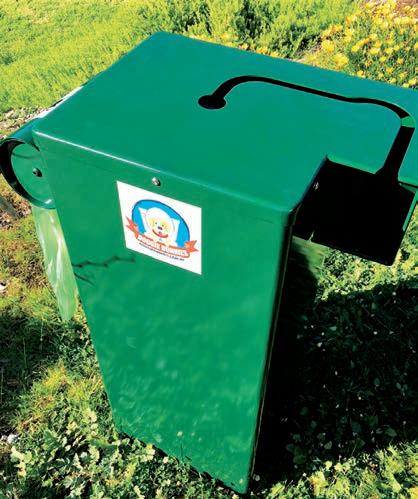
5 minute read
DOG DAYS
Decontaminating dog waste
LABELLED ‘MAN’S BEST FRIEND’S, BEST FRIEND’ WOODLAND’S DOGGIE DUNNIE STATION AIMS TO TREAT THE UNPLEASANT TASK OF COLLECTING DOG WASTE. WASTE MANAGEMENT REVIEW EXPLAINS.
As Woodlands Sales Manager Andrew Wynne remembers, dog waste collection bags were previously considered a novelty.
With the development of the Doggie Dunnie, Andrew is hoping to prove that a sustainable and contamination prevention method of collecting dog waste is no longer a novelty, but instead, a necessity.
“On average, dogs can require between five to six collection bags if you were to walk it three times a week. Previously, that would have been five to six plastic bags which would have ended up in landfill,” Andrew says.
“Alternatively, with the Doggie Dunnie, dog owners are able to dispose of their dog’s waste in fully compostable dog waste bags, which can all be recycled for re-use for outcomes such as fertilisers for local parks.”
Since its development five years ago, the Doggie Dunnie has seen its ease of operation, incorporation and Australian-made design used in several councils, caravan parks and recreational sporting areas.
By following four easy steps, dog owners can dispose of dog waste, knowing that they will be contributing to their own local circular economy.
Compostable dog bags are first tied, then threaded through a maze chute at the top of the bin. When threaded through to the end of the maze, the bag is dropped into the centre of the bin, where it is collected inside a bin lined and ready to be recycled.
“The arrival of the national rollout and support for Food Organics Garden Organics (FOGO) as well as the ban of plastic waste, coupled with a huge uptake of dog ownership during COVID-19, all contributed to increased demand for a product such as the Doggie Dunnie,” Andrew explains.
The Doggie Dunnie provides an alternative solution for dog waste disposal.
“If not solved, the disposal of dog waste is going to become an issue, especially as councils are aiming to reduce their own reliance on landfills.”
With its range of 55L with liner, 120L and 240L Sulo compatible units, the Doggie Dunnie reflects current bin specifications for most councils, allowing the units to be incorporated within an existing waste collection service.
Andrew explains that ease of implementation was an essential aspect during the product’s development and design phases.
“A council can use their existing infrastructure and funding to pick up the Doggie Dunnies, all without re-inventing the wheel,” he says. “Trials of the product in South Australia and Perth have proven the value that the Doggie Dunnie can provide to a council’s service.”
The Doggie Dunnie is also able to reduce waste odours inside of the unit with external ventilation, as well as an attachable lid, which can prevent the waste being contaminated by residue such as rain.
Trials have already been successful in Perth, in the City of Melville Council. Mayor George Gear says the trial has provided an in-depth look into how the units can be successfully implemented within the community.
“This trial will allow us to pick up the contents of these bins with our FOGO trucks and send for composting, which reduces the amount of organic waste being sent to landfill,” George says.
“We provide regularly stocked compostable dog waste bags at all parks and dog exercise areas across the city and we encourage the community to use these to pick up after their pets. The trial will provide us with valuable information and based on its success we will look to roll out more Doggie Dunnies around the city.”
ENCOURAGING EDUCATION
For Andrew, one of the benefits of installing the Doggie Dunnie is the ability to educate council residents. Through a detailed decal on the side of the Doggie Dunnie, residents can easily understand how to dispose of dog waste.
As he explains, residents within councils where the unit has been trialled have been granted a greater understanding of the outcomes from waste disposal, including the diversion of waste from landfill.
“If you are going to educate the community about dog waste you need to have an identifiable bin, which is why the Doggie Dunnie is clearly labelled and can come in a range of different colours,” he said.
“An uptake of recycling for products such as glass and plastic has been prevalent throughout the waste industry recently.
“We hope that dog waste can join this list of materials which, when
recycled, can create significant value in terms of re-use within the community.” The Federal government plans to halve the amount of organic waste being sent to landfill for disposal by 2030. By supporting the disposal of compostable bags, as well as providing compostable bags on the side of the unit in a brake-tensioned dispenser unit, the Doggie Dunnie is further promoting the recycling of FOGO waste. In South Australia and Western Australia, where the units have The Doggie Dunnie comes in a range of already been installed, the use of a sizes, including 55L, 120L and 240L. three-bin system (which will include a dedicated FOGO bin) will be established within the next four years. The system will also extend to the ban of non-compostable plastic bag circulation. By including the collection of dog waste within their services by installing the Doggie Dunnie, councils are getting a head start on the inevitable FOGO uptake within their regions. With trials persisting throughout South Australian and Western Australian councils the Doggie Dunnie product is continuing to be updated, with internal modifications increasing the capacity of the bins. With all signs pointing to an increased reliance on alternative forms of waste collection, Andrew says that looking after man’s best friend’s waste will help look after our own environment. “This is not only a tool for producing a positive outcome, but also a self-sustainable product for councils,” he says. “Councils are part of the solution if they are using the Doggie Dunnie.”

For more information, visit: doggiedunnies.com.au










